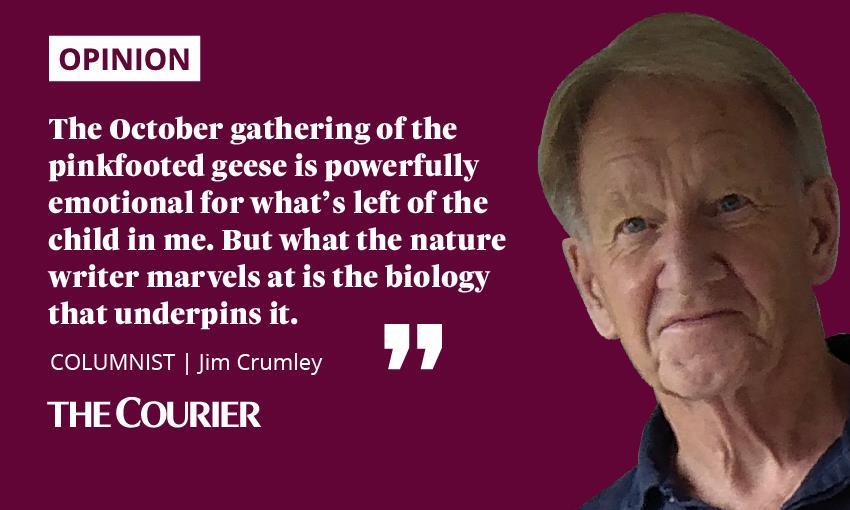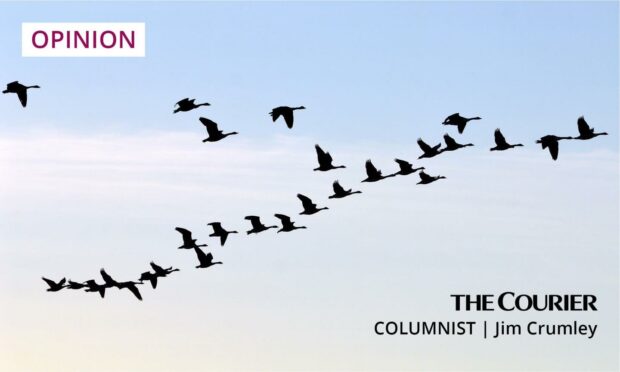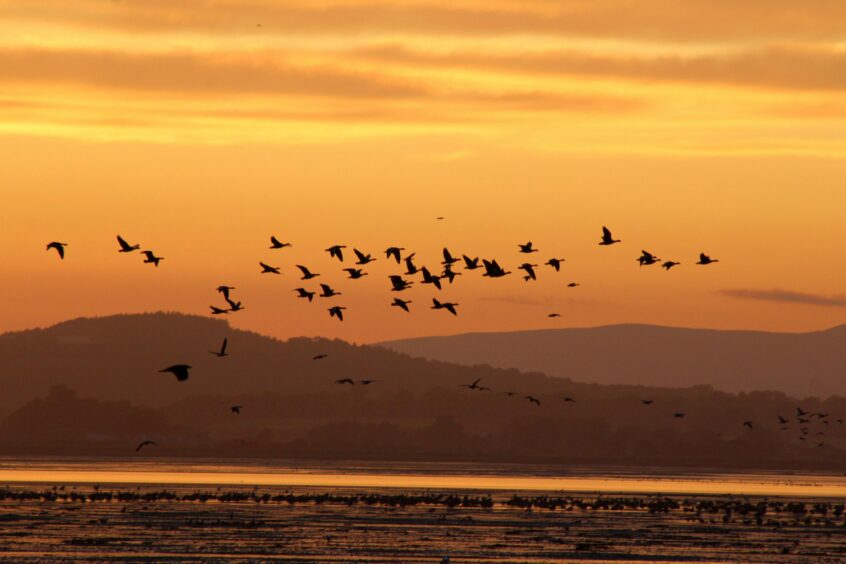The cafe was quiet on Sunday morning, the flat white just the way I like it, while I read two of the day’s newspapers. Old habits.
I lingered over a few news stories (Priti and Boris have fallen out – oh good!) and a couple of sports stories (Scotland won at Hampden – ye gods! – and we are in serious danger of qualifying for the World Cup) and an interview with the actor Brian Cox.
I like Brian Cox. I like to think of him passing my Illingworth grandfather in Lochee High Street when he was a bairn and my grandfather was the local cinema manager, and wonder if they ever exchanged a word or two in passing.
When I rose to go, for the few seconds it took me to walk from my table to the door my mind was still back in the force-field of the newspaper article.
Then I opened the door, stepped into the street, and the air was immediately full of geese.

The sight and sound of wild geese flying low over my parents’ Glamis Road prefab constitute my very first crystal-clear memory.
And suddenly my childhood self and my 2021 incarnation collided forcefully with each other on the pavement.
While we were both looking up, two skeins of pink-footed geese a few hundred yards apart, about 400 birds, flew directly overhead.
They were no more than 100 feet above the rooftops, heading west for the fields of the Upper Forth between here and Flanders Moss.
A sound to carry through the decades
Isolate the voice of a single pink-footed goose and it sounds like a squeaking gate.
But when the chorale of 400 such voices falls to earth it’s an anthem composed in the heart of Iceland or the east coast of Greenland, for that’s where the pinkfeet belong.
Fly away, Loch Tay.
Geese draw a line across the sky, breaking the silence with their honks. The noise carries across the glassy water, before being muffled in the mist. pic.twitter.com/CHRAKP6lrz— Calum Maclean (@caldamac) November 9, 2020
And if you happen to be standing on a pavement of a town with the River Forth snaking through it, but if you also happen to belong to the far side of the Tay, you can be excused if a daydream of the roost at Invergowrie Bay clouds your eyes momentarily.
For it was from there that the birds rose and climbed the brae where the prefab stood on their way to the fields of Angus.
It was there they returned in the evening, and always later if the moon shone, for then they would stay out later feeding in moon-brightened fields.
Man and boy, in awe of geese in flight
It’s 25 years ago now since I wrote my homage to my native heath, The Road and the Miles.
A poem slipped into its pages that bonded the here and now with the then and there of it, Flanders Moss with the prefab in the shadow of the Balgay that we cried “the Hully”.
A WHEEN O’ GEESE
A skein o’ westerin’ geese
– a wheen o’ whifflin’ weengs –
prowls aboo’ meh heid the nicht,
a featherweight ball and chain
that harks me back,
gaslit Dundee ablow
their frosty sing-songs, lullabeh
as soothin’ as Winnie the Pooh
or Horlicks. Fifies ferried
dreams to Newport then
and Dundee’s thumpin’ hert
was stane.
But far from then and there
– on Flanders Moss the nicht –
the ring aroond the moon
ignites a when o’ geese
and in meh hamesick heid
it reconvenes the Hully’s peace.
The October gathering of the pinkfooted geese, then, is powerfully emotional for what’s left of the child in me.
But what the nature writer marvels at is the biology that underpins it.
The geese are gathering
Right now, something like 95% of the entire population of the Greenland and Iceland birds is gathered in Scotland.
They are on just a handful of watersheets, notable among them Montrose Basin, Loch Leven and Dupplin Loch near Perth.
From these, the huge gatherings disperse along flyways familiar to the species from many, many old Octobers.
Some will head further south for Lancashire or Norfolk, but most head for Borders lochs or places like Aberlady Bay on the Lothian coast, the Lake of Menteith near Flanders Moss, and Invergowrie Bay.
It’s a longer haul up from the bay to the fields than it used to be, given that the city’s outskirts are more voluminous than they were when Glamis Road was the last street in town.
But they carry the flight plan of their own DNA with them, and many of the landmarks are unchanging.
And come the spring, they reverse the process and gather again for the long haul back up the northern ocean.
Meanwhile, another October day dawns.
I’ll scan the sky, ears attuned for something between a squeaky gate and an Arctic anthem, heading for the cafe.

